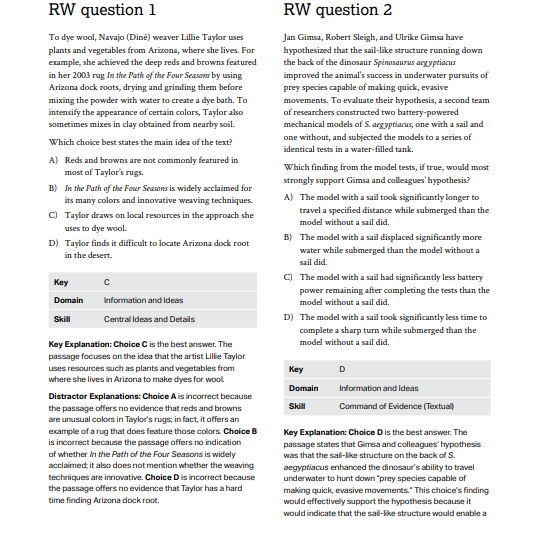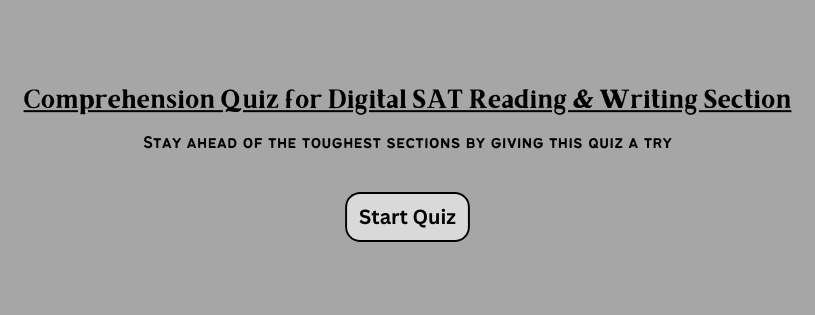Top SAT Reading and Writing Section Tips To Boost Your SAT Score
The SAT Reading Test is about seeing how well you understand different types of texts. The questions are all based on passages, some with charts or graphs. In each test, you'll have five passages, each with 10 to 11 questions, making a total of 52 questions. You get 65 minutes to complete the reading test, and the five passages include four on their own and one pair of passages you read together.
Explore the SAT Course Book a Free Trial Session
Digital SAT Reading Section:
| Reading Section Format | |
| Duration | 65 Minutes |
| No. of Questions | 52 MCQs (Each have 4 options) |
| Total Passages | 4 Standalone, 1 Paired |
| Words Per Passage/Passage Set | 500-750 Words |
| Passage Type | |
| U.S. and World Literature | 1 Passage – 10 Questions |
| History/Social Studies | 2 Passages/ 1 Standalone & 1 Paired – 10 to 11 Questions each |
| Science | 2 Passages/ 1 Standalone & 1 Paired – 10 to 11 Questions each |
| Skills Assessed in Reading Test Questions: | |
| Information/Ideas | Understanding the details, finding proof in the text, figuring out the main ideas and themes |
| Summarizing | Grasping connections between things, figuring out the meanings of words and phrases |
| Rhetoric | Examining the words used, understanding how the text is organized, looking at the big picture and small details, thinking about different perspectives, figuring out why the text was written, and evaluating the arguments presented |
| Synthesis | Comparing different texts, understanding numerical information |
Digital SAT Writing & Language Section:
| Writing Section Format | |
| Duration | 35 Minutes |
| No. of Questions | 44 MCQs (Each have 4 options) |
| Total Passages | 4 Passages (Each has 11 Questions) |
| Words Per Passage/Passage Set | 400-450 Words |
| Skills Assessed in Writing & Language Test Questions: | |
| Expression of Ideas (24 questions): | These questions check how well you can express your thoughts. They look at how you develop your ideas, organize them, and use language effectively. |
| Standard English Conventions (20 questions): | These questions focus on how you construct sentences, use language correctly, and apply punctuation. They look at sentence structure, proper language usage, and punctuation rules. |
What do the Reading Test Questions mean?
The reading test questions can be grouped into three types:
1. Information and Ideas: These questions are about what the passage is saying, whether it's stated directly or indirectly.
2. Rhetoric: These questions inquire about how the author expresses meaning in the passage.
3. Synthesis: These questions ask you to come up with conclusions and find connections between two passages, or between passages and visuals like charts or graphs.

Reading Test Passages Topics:
The reading test has passages about different things, and they fall into two main types:
1. Literary: This is about made-up stories from the United States and other places in the world.
2. Informational: These passages cover topics like science, social science, important historical documents, and the important global conversations they start.

Comprehension Quiz for Digital SAT Reading Section:
Stay ahead of the toughest sections by giving this quiz a try.
Get ready for the SAT Reading and Writing Sections by practicing with a variety of reading passages:
Watch these videos, jot down important points, and respond to each question with a SAT teacher.
SAT Reading Tips: Ultimate Guide to Get Perfect SAT Reading Score
The reading section takes up about 50% of the Evidence-Based Reading and Writing section of the SAT. The other half is covered by the Writing and Language test.
This breakdown might make the Reading Test look invincible, but with a clear approach and good preparation, you can easily get a perfect SAT Reading Score.
SAT Reading Preparation Course:
| SAT English Preparation Courses | Duration | SAT Reading Course Details |
|---|---|---|
| SAT English(Reading, Language, and Writing) | 60 Hours | SAT English Course Details |
| SAT English- Reading | 60 Hours |
What is Exactly Tested in the SAT Reading Section?
It’s obvious that Indian students (NRI), are expected to be aware of what’s tested on the international SAT reading section. Throughout this article, you will grab all the necessary information that you should know about the expectations of the examiner's side before stepping into the examination hall.
What is the SAT Reading Section?
Let’s first have a brief look at what the SAT Reading Section will have:
The SAT Reading section will have 52 questions over 65 minutes. All questions will be multiple-choice, having options like A, B, C, and D. Moreover, questions will be based on passages (four individual passages and one set of paired passages).
Take the help of the following chart to know about the format of SAT reading:
|
Section |
Time in Minutes |
Number of Questions |
Time per question |
|
Reading |
65 |
52 |
75 seconds |
In brief, you will need to answer 10 to 12 questions on each passage. You will get some passages to accompany with a graphic, like a bar graph, chart, or scatterplot.
Besides, you need to be aware of how many questions and how much time you need to solve those questions, you also have a basic sense of what passages will be.
Moreover, you should know about the SAT reading questions as well.
Types of SAT Reading Questions:
There are 8 types of SAT Reading questions that every SAT applicant will be facing. Let's dive into the 8 types of SAT Reading questions.
Main Point: Here you need to describe the overall objective or message of the passage. The objective of each passage is:
- Compare intellectual skills to those who play games on the web along with those who browse it.
- Delineate on the problem-solving skills of individuals to diverse levels of web experience.
- Make a solution to electronic media effectively.
Detail: Here you need to write about the specific details. For this, you will need to refer to a specific line or two within a passage.
Inference: Here you will be asked to interpret the meaning of a line or a paragraph or the entire passage. These should not be an elaborate form.
Vocabulary in Context: Here you will need to write about the meaning of a specific word. For example- words like Superior, genuine, inferiors, superstitious, etc. can be asked.
Function: Here, you will consider mentioning how a sentence or a line or a phrase works within a passage.
Author Technique: Here, you will need to write about the intention of the author writing a passage. You can describe the author’s style, voice, tone, attitude, or perspective.
Evidence Support: Here, you will be asked to refer to any previous question you have written to evidence your answer.
Data Interpretation: The final type of question that you will consider to answer on the SAT reading section is data interpretation. For this, you will assign charts or graphs, where you need to interpret the information presented therein.
Do you notice that these types of questions analyze your reading comprehension skills? Moreover, recognize the question type will help you grab the accurate skills to answer it. You will able to figure out the wrong answers too.
How Should You Study for SAT Reading?
Besides, you should be aware of the thorough understanding of the questions you will get on your SAT reading exam day.
Lets’ know strategies suggested by the experts, exclusively for your international SAT reading test:
- Make sure to brush up on Literary terms
- Make sure to practice data Interpretation
- Make sure to read daily and read widely to hike up your critical reading and comprehension skills
Tips for a Great SAT Reading Score
1. Practice to Avoid Surprises-
You’ll have 65 minutes to read five passages and answer 52 questions. The questions will ask you
2. Skip harder Questions-
You don't have to necessarily answer every question. The harder questions can be skipped and you can leave some questions if you feel like. Learn More about SAT Reading Test strategies further down the blog.
3. Read what you Need-
You don't have to be waste your time reading every word of the passage. You have the passage and questions in front of you. Go, move back and forth to get the answer.
4. SAT is not your English Class-
Unlike your English class, the SAT doesn't want your opinion. Answers to questions in SAT are directly stated in passages, so don't let your opinions cloud your judgment.
5. Avoid mixing questions of Dual Passages-
One of your science or history/social studies passages will be a set of dual passages—two shorter texts about one topic. Do questions about the first passage first, questions about the second passage second, and questions about both passages last. This will save time and keep you from confusing the two passages when you’re evaluating the answer choices.
Put these reading strategies to the test. Try your hand at some SAT English Preparation Course.
SAT eBook
It is very important to know minor to major facts when starting your preparation for an aptitude-based exam like SAT, with updates that can help with your SAT preparation.
We are pleased to announce the release of TestprepKart's free SAT study guide for the new SAT. This free SAT ebook gives you everything you need to know about the test, from content to content mastery, among the top practice goals you need.
SAT Reading FAQ:
A: The SAT Reading Test is designed to assess how ready you are to read and interpret the kinds of texts you're likely to encounter in college and career.
A: Here's how it goes: Before you read the passage, go to the questions and read each one. If the question refers to a series of lines, mark those lines on the passage. Take a brief note about the gist of the question. Go back to the passage and skim it.
A: 460 SAT Score Standings Out of the 2.13 million test-takers, 2134155 scored the same or higher than you. You can apply to 14 colleges and have a good shot at getting admitted. You have a very low chance of getting into 1484 schools with this score.
A: 52 The test, without the SAT essay, consists of three sections: reading, writing and language, and math. The SAT features a 65-minute reading test comprised of 52 multiple-choice questions. Another section is the writing and language test, which lasts 35 minutes and has 44 multiple-choice questions.
A: For Evidence-Based Reading and Writing, you can skip/answer incorrectly on average 9 questions on the writing portion and 12 questions on the reading portion.
A: SAT reading is hard because students have to remain focused on a long passage that is boring, even fiction-based passages can be boring. When students form the habit of losing focus and doing nothing, they find it difficult to complete a passage about ecosystems in regions of the Amazon
A: The median is the 50th percentile, meaning that half of all test takers got lower scores and half got higher scores. If you get a composite SAT score of 1083 or more, you are above average. The 75th percentile composite SAT test score is 1215, the 90th percentile is 1340 and the 95th percentile is 1410.




Leave a Reply